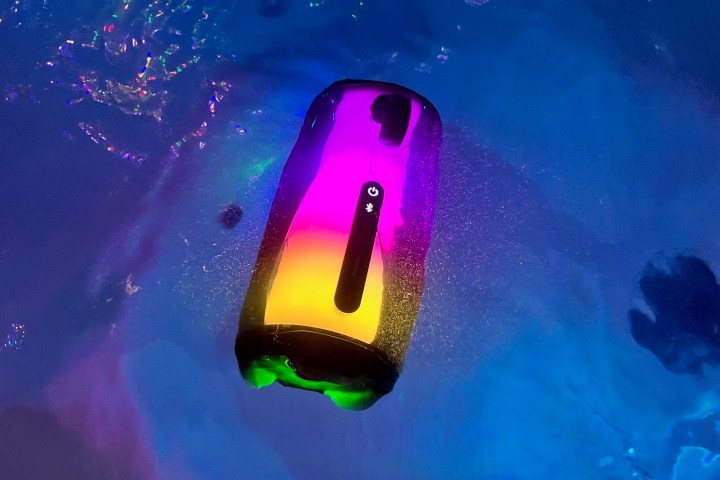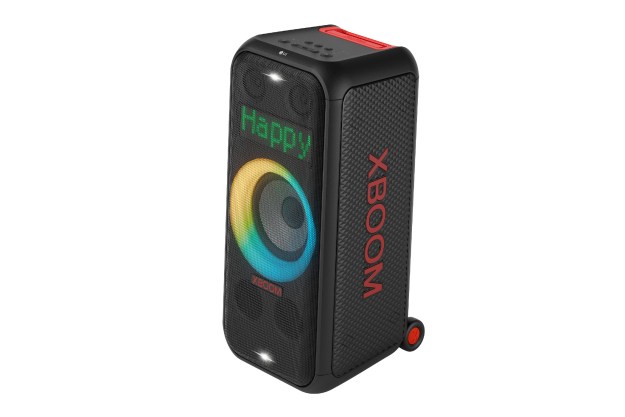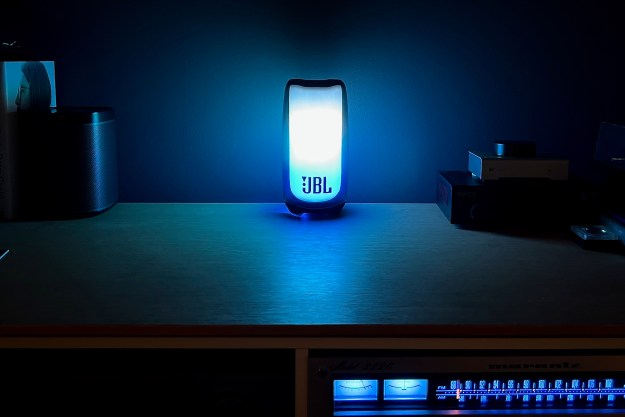
“The JBL Pulse 5 is a decent-sounding, waterproof, Bluetooth speaker that puts on an LED show to fit any mood”
- Bright, vivid light features
- Dustproof, waterproof IP67 rating
- Clear, dynamic sound
- Feature-rich app
- Basic EQing in-app
- A bit lacking in bass
- No AUX input
- Lacks physical controls
JBL’s Pulse Bluetooth speakers have long been popular for their fun and cool-looking lava-lamp light show features, and we’re happy to report that the latest version, the Pulse 5, is just as trippy as its brethren, with a few upgrades and new features to keep the line going strong. While its 360-degree LEDs are easily the main draw here — they’re colorful and have a bunch of customizable light show settings you can adjust via its app — the sound the JBL Pulse 5 pumps out is decent, but only suitable for small- to mid-sized rooms on its own, or bigger rooms when linked up to other Pulse speakers. Beachgoers and pool partiers might forgive the Pulse 5’s sound deficit because it’s waterproof and dustproof, making it a great ally outdoors.
The Pulse 5’s hefty $250 price might make it worth having a look at other JBL Bluetooth speakers, like the excellent Flip 6 or the booming Xtreme 3. That said, if you’re as dazzled by the design and gorgeous ambiance light features of the Pulse 5 as I was, and you’re not in need of a speaker that shakes the walls, read on for what we liked and didn’t like about JBL’s latest lava lamp with speakers.
Design and features

Like the JBL Pulse 3 and Pulse 4 before it, this latest fifth generation of JBL’s popular upright portable Bluetooth speaker is simply gorgeous. The entire outer shell of the Pulse 5 is clear plastic all around, save for the top and bottom caps which house the Pulse 5’s top upward-firing 0.6-inch tweeter and the bottom, down-firing 2.5-inch 30-watt woofer that gets just under an inch of clearance thanks to the device’s three rubber feet.
Pushing the psychedelic aesthetic even further, behind the clear shell is the speaker’s core of brilliant LED lights, which seemingly floats, moves, and color-shifts like a glob of melted wax in a more modern lava lamp.
The only other features interrupting the flow of the Pulse 5’s clear shell are its sturdy nylon loop strap and a beautifully compact 3.5-inch long panel of physical controls that houses the USB-C charging port, power, Bluetooth, and PartyBoost connectivity buttons (for pairing multiple Pulse speakers together), as well as a button to control the LEDs (on, off, and a long-press lets you change the mode) and a power-level light.
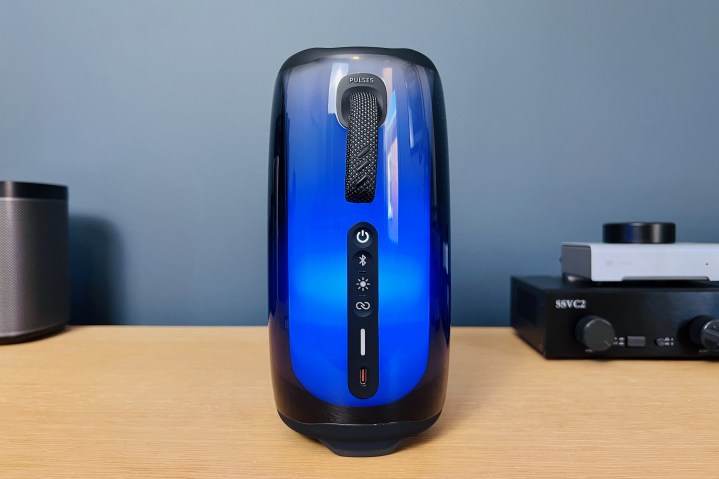
Achieving this clean flow, however, comes at the expense of any physical playback or track navigation controls, which the Pulse 4 has. I often found it a nuisance having to always reach for my phone to adjust the volume or pause a track, especially when my device was in another room. Maybe the decision was made to dissuade people from touching the clear speaker, which may not have been a bad idea considering the fingerprints and smudges it picks up.
On its own, a single Pulse 5 delivers mono sound (we’ll get into how it sounds below), but when connected to another Pulse with the PartyBoost feature, a stereo pair can be created. Or you can link multiple compatible speakers for a bigger sound. I only received one review unit to test out, so I was unable to try this feature.
With no AUX in port, the JBL Pulse 5 relies solely on its Bluetooth 5.3 connectivity with the standard SBC codec support, which is sufficient, but for $250, support for higher quality codecs such as AAC (found in the excellent, and cheaper, Sonos Roam) would have been nice. It does have Bluetooth multipoint, though, so you can pair up to two devices to the Pulse 5 simultaneously in case you and a friend want to divvy up the DJ responsibilities.
The Pulse 5 has the best light show features of any portable Bluetooth speaker I’ve ever seen, and it’s a ton of fun.
Lastly, and perhaps most importantly, is that even though the JBL Pulse 5 might look more like a speaker you’d find in a hazy, dimly lit, wood-paneled basement, like many of JBL’s rugged outdoor speakers the Pulse 5’s IP67 rating makes it virtually dust resistant and able to be dunked in up to a meter of water for up to 30 minutes. I decided to test it out in my hot tub, casually knocking the speaker into the bubbling water.
Its 3.5-pound weight plunged it down a little before it happily bobbed back to the surface — it floats! To be clear, it’s not meant to be listened to in or underwater — the IP67 rating just means that it can withstand it — so there was little sound coming from it as the water enveloped the speakers. Removing the speaker from the water, the sound was muffled and the bass was severely distorted, which worried me at first. But after tipping the speaker over end-t0-end and draining the water out, it only took a few minutes before the Pulse 5’s sound cleared up.
To be clear, the Pulse 5 is not a “rugged” speaker, so I’d be careful not to knock it off a table or toss it around like a football (that would look cool, though). But a poolside sound and light show is the perfect venue for the Pulse 5.
JBL Portable app and LED controls
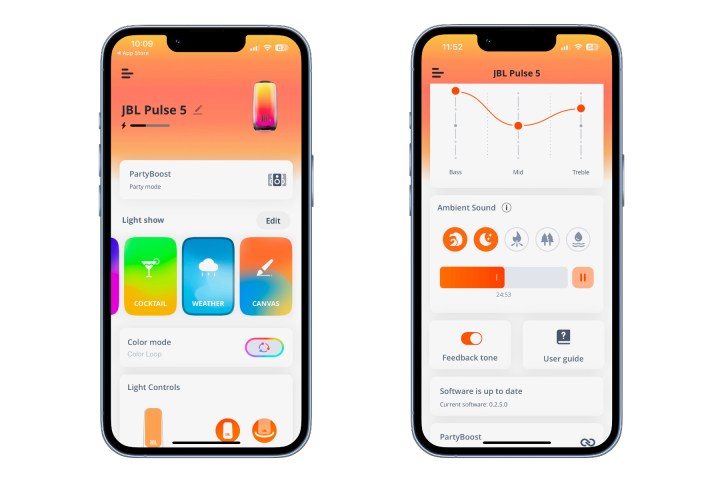
Pairing the JBL 5 to your device, be it a smartphone, tablet, or computer, is as easy as pairing any Bluetooth device. Once paired, you can of course play music from your favorite streaming services, or push the sound to it from whatever you’re watching on YouTube or Netflix.
The JBL Portable app (free for Android and iOS devices) is a well-designed, easy-to-use app that adds a handful of helpful and fun features and controls as well. From the home screen, you instantly see the battery life of the speaker. Sound features include simple bass, mid, and treble EQ sliders (be sure to disable or take into account the EQ settings on your streaming app, though, because they’ll both affect your music) and a selection of Ambient Sounds you can play for sleeping or background noise, such as waves, crickets, campfire, and bird sounds that can be put on a timer. You can also control the PartyBoost feature here, too.
But let’s get to the fun part of the Portable app — light controls. There’s nearly no limit to the amount of tweaking you can do to the Pluse 5’s LEDs, which are in two sections: the main base of the cylinder and radiating underneath with the woofer. the Light Controls selection allows you to turn them on or off and a slider lets you set the brightness level.
For a speaker with drivers of this size, the Pulse 5 delivers exceptional clarity in the mids and highs, especially on vocals.
There are six Light Show presets each with editable sub-themes, including Party, Cocktail, Weather, Canvas, Spiritual, and Nature, all of which can be set to a specific color or on a random color loop. You can even change the tempo of the light’s changing speed to suit a mood, from slow and super chill to upbeat freakout. The Pulse 5 has the best light show features of any portable Bluetooth speaker I’ve ever seen, and it’s a ton of fun.
Sound quality and performance
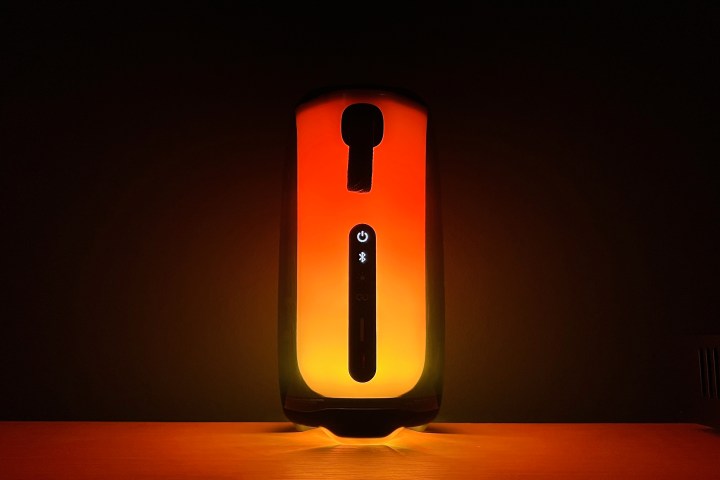
While the Pulse 5’s focus seems to be more on the light show, for a mono speaker of its size it’s reasonably loud, sounds pretty decent, and will be enough to satisfy most people. For my test, I used Spotify (Tidal’s lossless audio would be totally lost on this speaker) and started with the EQ off on both the Spotify app and the JBL Portable app, as well. I first tested the speaker in my small home office my media sideboard unit about six inches from the wall.
For a speaker with drivers of this size, the Pulse 5 delivers exceptional clarity in the mids and highs, especially on vocals in tracks from the likes of Radiohead, Paramore, Bad Bunny, and even heavier fare from Metallica. It might be a bit treble-forward for my liking, and a bit tinny at higher volumes, but overall it sounds great. Don’t push this speaker though — things start to break up a bit at the very limits, but if you’re looking for something to fill a bigger room then you might want to try the Sony SRS-SG300.
On the low end of the spectrum, the Pulse 5 was a little disappointing with the no-EQ settings I started out with. At higher volumes, it was present and rumbled the table, especially on bass-heavy songs like Billie Eilish’s xanny, which is kind of my litmus test as it’s mixed pretty saturated and comes through no matter what speaker I listen to it on. However, things start to get interesting when you turn on the Portable app’s EQing and goose the bass. The sound fills out and gets bigger and wider. Then, turning off the Portable app’s EQ and instead using Spotify’s native EQ was even better, allowing for more flexibility and dynamics in the mix. The flat EQ setting is balanced and clear on the Pulse 5, and with some boosted bass, it sounds great and gets loud.
The JBL Pulse 5 handles most sound situations relatively well and performed admirably everywhere I put it.
With more piercing tracks, like Smashing Pumpkins’ Cherub Rock, though, I had to ease off on the 2.4kHz and 15kHz frequency sliders that were piercing my ears. All this is to say that if you’re willing to do the tweaking, this thing can sound excellent, and especially shines at mid to lower volume levels.
Moving the speaker around — in a corner, on a bookshelf, out in the open — yields different sound dynamics, like any speaker, and I didn’t have any issues with the Bluetooth connectivity. The JBL Pulse 5 handles most sound situations relatively well and performed admirably everywhere I put it. Is it worth $250? Considering what else is out there at this price, I’m not so sure.
Battery
The JBL Pulse 5 is a portable Bluetooth speaker that one would assume will be taken to a variety of places to dazzle friends and partiers with its cavalcade of lights and sound, so it’s important that it has enough battery power to do so. With a 7,500 mAh battery, JBL claims that the Pulse 5 can last for up to 12 hours, which is about average for a Bluetooth speaker of its size (the Sonos Roam and Move, in comparison, clock around 10 hours, while our top-rated Marshall Emberton II boasts a substantial 20 hours). The Pulse 5 takes around four hours to fully charge from zero with the included USB-C to USB-A cable.
Bottom line
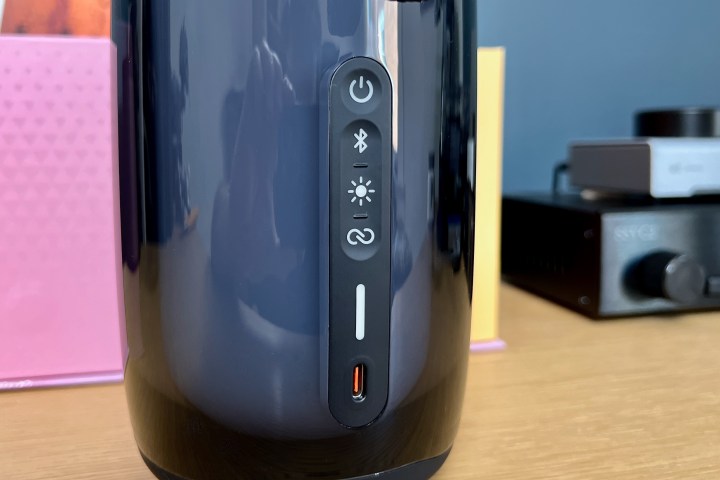
In the case of the JBL Pulse 5, I’m going to say that it’s totally OK to be dazzled by all the pretty lights and worry less about the sound. Because, dammit, this thing looks super cool, it can create a great lava lamp or party vibe, and the sound is good and loud enough to impress. Are there portable speakers out there that cost less than $250 and offer better sound quality? Sure there are, and we’ve mentioned a few throughout the review (you can also see more in our roundup of the best Bluetooth speakers). But if you’re less fussy about high-res audio or better Bluetooth codecs and are looking for a fun, unique, portable sound and light show that’s as at home by the pool (or in the pool) as it is in your chill-out den, then the Pulse 5 might be a little extra money well spent.
Editors' Recommendations
- Bluetooth on Sonos’ new Era speakers isn’t what you think – it’s better
- What is Sonos? The speakers, app, and everything you need to know about wireless music
- The first Roku-made televisions are now available at Best Buy
- 11 Sonos tips, tricks, and little-known features
- Sonos’ new Era 100 and Era 300 wireless speakers go all-in on spatial audio and Bluetooth


